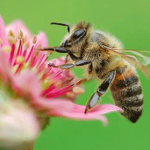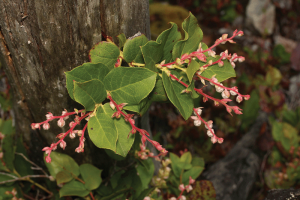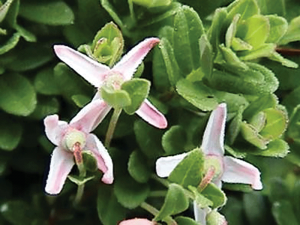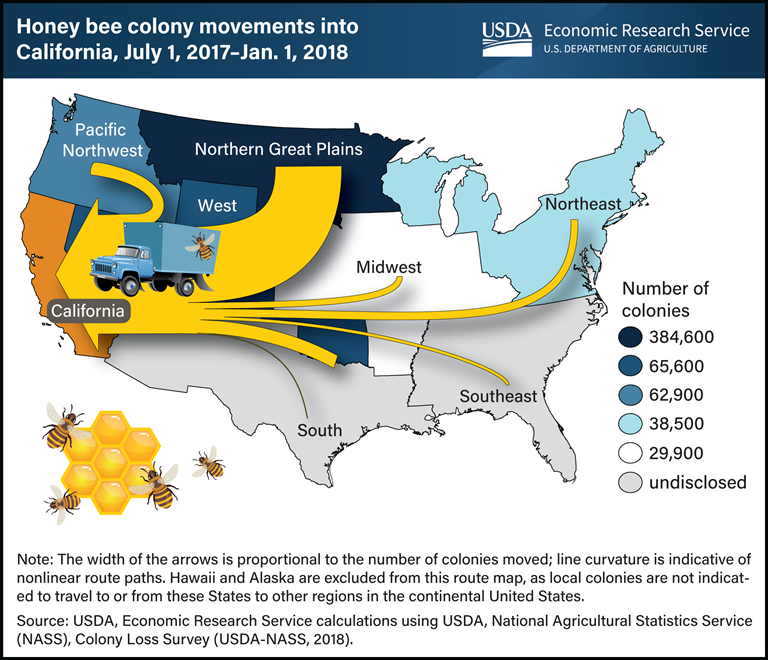In this series thus far we’ve jumped hither and yon over much of the West. This month, we’ll focus on the Northwest. “Pacific Northwest Foraging-120 Wild and Flavorful Edibles from Alaska Blueberries to Wild Hazelnuts” by Douglas Deur (290 pages, ISBN 978-1-60469-352-2) was released by Timber Press.
This volume covers Washington and Oregon as well as parts of Alaska and Canada. Since it turns out that about seventy of these edible species happen to be pollinator plants, I highly recommend this title to beekeepers. Many of the plants or their relatives can be found in other regions as well.
Around half of the pollinator species in this volume have been profiled over the years in Bee Culture articles. Bear in mind that there has been some overlap in these books with some plants being featured in more than one volume. Around 25 species for bees that I mentioned in previous reviews are also in this title, so I won’t bother repeating them here.
In addition, this volume has a number of other pollinator species that haven’t been covered in earlier articles. Those plants providing surplus honey are arrow-head, waterleaf, and Labrador tea. Ones that are sources of nectar and pollen are balsam root, chicory, and Indian peach. Yerba buena brings nectar, while the western skunk cabbage is rich in pollen. In addition, biscuit root is a source of pollen and possibly nectar.
Like the other volumes in this series, this one has the plants arranged alphabetically by common name. The in-depth plant profiles feature the Latin and common names, the edible plant part/parts, plant description and ID tips, where and when the plant can be found, how to prepare the food, stewardship guidelines regarding replanting the species in the wild, and safety concerns.
The introduction covers the many reasons for foraging and the various habitats within the region and the edible plants present in each habitat. The author stresses the need to be certain about plant ID when foraging.
He purposely chose more flavorful species that are plentiful, and are either easier to collect or require less time to gather. In addition, rare or threatened species or those that can be confused with a toxic look-alike are excluded from this volume. The seasonal foraging guide lists the plants by plant part/parts for each season and habitat.
The author is a specialist in Native American traditions and serves as a cultural ecologist for native peoples of western North America. This serves to explain why he stresses the role these plants play in Native American communities as well as the issue of sustainability both in the introduction and in the individual plant profiles.
Of the many excellent pollinator plants in this volume that will be of interest to beekeepers, I’ve chosen salal and the American cranberry partly because they can be grown in the North. Both of these species happen to be members of the heath family, which means they’re relatives of the blueberry.
Salal (Gaultheria shallon)
There are several related species in this genus, including wintergreen. However, I found no indications that any of these relatives are sources of pollen or nectar. Salal is an evergreen shrub that is native to Alaska, Washington, Oregon, and California.
This species is most often found on wooded slopes, clearings, clear cuts, open areas, and the redwood belt as well as an understory species. Salal was one of the plants reported by the Lewis and Clark Expedition. In December of 1805, Clark wrote about having been served foods prepared by Native Americans that contained the berries.
The plant’s height as well as the growth habit is largely determined by the growing conditions. When given poor sites or full sun, salal will assume a mat-like habit and usually be less than a foot in height. On the other hand, in full shade the plant will develop more luxuriant growth and be taller – five to seven feet in height or more with a spread of three to eight feet.
Spreading by stolons, salal can continue to become wider each year so that eventually it can form a thicket. This attractive shrub produces arching stems.
Clark described the older bark, particularly on the larger stems, as being greenish-red and that of the younger stems as red when growing in full sun. The lovely, shiny, leathery, bright green foliage can be round to oval. The margins are typically undulating.
With red undersides, the leaves range from 1¾ to five inches in length. Borne on long red shoots, the foliage is so attractive that lots of the cut stems are harvested in the wild each year. These are sold to florists, who use them in floral arrangements.
Borne in showy clusters that are three to six inches long, the axillary blossoms of salal resemble those of the blueberries. The waxy, bell-like blooms are mostly white tinged with pink. Sometimes, they can also be pink. About ½ inch in length, these appear from March through June, depending on the location.
Salal berries emerge in slender, drooping or arching clusters on the current year’s growth. One-half-inch wide, the fruits ripen in Fall to black or purple. They pretty much resemble huckleberries. and are typically made into syrups and pemmican. Each cluster contains ten to twelve fruits.
Growing Salal
This native thrives in the West and can be grown successfully in parts of the East provided it is given suitable conditions. In western states, salal is reasonably hardy in zone six, although some dieback might occur in colder areas when Winters are particularly severe.
For eastern gardeners, salal is most suited to zones seven and eight. It has sometimes been grown successfully in the Northeast in dry shade and full sun. In warmer areas of the East, the plant likes some shade.
Preferring a somewhat dry to moist soil, the vigorous plant loves acid conditions. Salal is a great choice for rock gardens and landscapes. As a ground cover, it is ideal for banks and mass plantings. Several cultivars are available.
Rarely needing pruning unless it has become terribly neglected and overcrowded, the plant generally requires minimal routine care. This is best planted in the Fall using either container plants or sod.
This is propagated by seeds and cuttings. The spacing does vary slightly by growing conditions. Space the plants four feet apart in the shade and about half that if planting in full sun.
Bee Value of Salal
Around a century ago, salal was a major honey plant in the area. Since that time, the plant has become less common due to various factors, such as logging, land use change, and development. The blossoms produce a lot of nectar.
Honey surpluses are possible when the plants are plentiful. The pleasant tasting honey is light amber.
American cranberry or large cranberry (Vaccinium macrocarpon)
The Latin species name refers to the large fruits. This native is found in Washington, Oregon, California, Minnesota, Wisconsin, Michigan, Indiana, Illinois, Ohio, and throughout the Northeast southward into Tennessee, West Virginia, Virginia, and North Carolina. Its habitats include bogs – especially sphagnum bogs – swamps, wet shores, mountains, and coastal plains. In the past, the Nature Conservancy has offered public tours during the Fall of a cranberry bog it owns in Shady Valley, Tennessee.
Suitable for zones three through seven, this dense, low growing, fine textured evergreen ground cover is creeping or trailing. This native is only one to six inches in height with an indefinite width. The plant spreads by the ground-hugging, forked, very thin stems that can root at the nodes. The stems can be three foot in length.
When it initially emerges, the new growth typically has a bronzish cast. The edges of the closely spaced foliage tend to curl backwards. The blunt, rounded to oblong-elliptic, shiny leaves are ½ to ¾ inch long.
The deep green to medium green foliage is typically a lighter color, sometimes whitish, on the underside. As Winter approaches, the leaves turn reddish.
Very floriferous, cranberries have axillary blossoms that emerge on flowering branches that are taller than the other stems. A cranberry bog in full bloom is a sight to behold and has been described as “a pink cloud.” Depending on location, the solitary, nodding flowers appear from May to July.
The blooms are pink with either white or red tinges. These feature petals with edges that curl downward, a four-clefted corolla, and conspicuous, beak-like stamens.
Borne on six-inch-long, upright, erect stalks, the long-lasting fruits can vary slightly in shape. They’re ½ to ¾ inch wide. The undersides not exposed to the sun can be white rather than red. They ripen from September into November. These familiar, small, acid tasting berries have been praised highly for their healthful qualities.
Cranberries typically begin yielding their first crops of fruits during the first or second year after planting. In large bogs, the berries are traditionally harvested with a harvest rake. A plastic, hand-held rake that can also be used for harvesting lowbush blueberries and lingonberries is available from various fruit plant catalogs.
Growing Cranberries
Several cultivars of cranberries are available to beekeepers and homesteaders. These include Stevens, which is very fruitful and bears particularly large berries. Pilgrim, which also produces large berry crops, is six inches tall and bears wide spreading branches.
Cranberries are grown commercially in Massachusetts, New Jersey, Wisconsin, Washington, and Oregon. The growing information here deals only with recommendations for bee gardens and homesteads rather than for commercial bogs. Keep in mind that a bog is unnecessary provided one’s garden soil is kept moist.
Suited to sun and light shade, these plants require a moist, acid soil with a pH of 4.5 to 5. They do well in wetlands and other wet or flooded soils. Peat and sand are ideal as are rich soils high in organic matter.
Michael A. Dirr, a renowned woody plant specialist and author, has written about growing these plants successfully using a mix of one-half sphagnum peat and one-half garden soil. Cranberries do require watering during dry periods because these happen to be a shallow rooted species.
Space the plants one foot apart in rows that are two feet apart. Keep the bed mulched to protect the roots from heat and drought. Because cranberries are hard to propagate from cuttings, it is generally best to buy container plants.
Generally home gardeners find the plants to be relatively pest and disease free. However, the same isn’t true for commercial cranberry bogs.
Bee Value of Cranberry Plants
Cranberries are considered major bee plants in the West, Northeast, and North Central regions. Bees gather nectar and pollen from these blossoms. The amount of nectar does vary slightly by conditions, and can be adversely affected by wind, rain, and cold.
The blooming period typically lasts for three to four weeks or so. Assuming the plants are plentiful, beekeepers can harvest a surplus crop of high quality, reddish honey with a pleasant, berry-like flavor free of acidity.
The Role of Bees in Cranberry Pollination
Strictly speaking, cranberries are said to be self-fertile. Yet, the fact remains that cranberry growers benefit greatly when bees provide pollination. Study after study since the 1960’s have shown that pollinated plants produce many more fruits.
While a typical unpollinated plant bears about fifteen fruits, the pollinated ones can yield up to 150. In addition, the pollinated ones yield larger berries that mature and ripen more evenly, and larger crops overall than the unpollinated ones. Various pollination studies confirming the benefits of bee pollination have appeared in Bee Culture over the years.
Cranberries are dependent on bee pollination largely because in most areas native pollinators, such as bumblebees, have experienced declining populations. This is particularly the case for bumblebees, which began their decline in the 1960s, reports S.E. McGregor in “Insect Pollination of Cultivated Crop Plants,” USDA Agriculture Handbook No. 496.
A general recommendation is to use one colony for each two to three acres of cranberries. When native pollinators are absent, this should be increased to one hive per acre. Generally, cranberry growers are using one strong hive per acre.
Connie Krochmal is a beekeeper, writer and plant expert living in Black Mountain, North Carolina.











